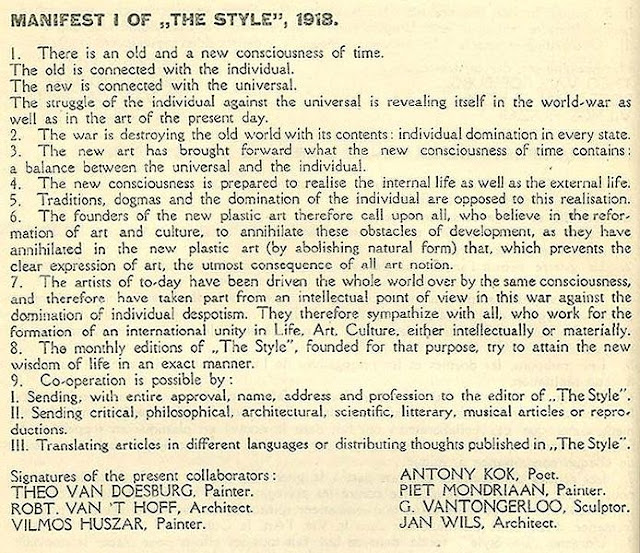De Stijl –
The Dutch artistic movement founded in 1917 to 1931 the movement proposed ultimate simplicity and abstraction through which they could express a Utopian idea of harmony and order.
Early history and political movements
From the flurry of new art movements that followed the Impressionists' revolutionary new perception of painting, Cubism arose in the early twentieth century as an important and influential new direction. In the Netherlands, too, there was interest in this "new art."
However, because the Netherlands remained neutral in World War I, Dutch artists were not able to leave the country after 1914 and were thus effectively isolated from the international art world—and in particular, from Paris, which was its centre at that time.
During that period, painter Theo van Doesburg started looking for other artists to set up a journal and start an art movement. Van Doesburg was also a writer, poet, and critic, who had been more successful writing about art than working as an independent artist. Quite adept at making new contacts due to his flamboyant personality and outgoing nature, he had many useful connections in the art world.
Other movements during the De Stijl movement
Around 1921, the group's character started to change. From the time of van Doesburg's association with Bauhaus, other influences started playing a role. These influences were mainly Malevich and Russian Constructivism, to which not all members agreed. In 1924, Mondrian broke with the group after van Doesburg proposed the theory of elementarism, proposing that the diagonal line was more vital than the horizontal and the vertical. In addition, the De Stijl group acquired many new "members." Dadaist influences, such as I.K. Bonset's poetry and Aldo Camini's "antiphilosophy," generated controversy as well. Only after van Doesburg's death was it revealed that Bonset and Camini were two of his pseudonyms.
Founding of De Stijl
Around 1915, Van Doesburg started meeting the artists who would eventually become the founders of the journal. He first met Piet Mondrian at an exhibition in the Amsterdam Stedelijk Museum. Mondrian, who had moved to Paris in 1912 (and there, changed his name from "Mondriaan"), had been visiting the Netherlands when war broke out. He could not return to Paris, and was staying in the artists' community of Laren, where he met Bart van der Leck and regularly saw M.H.J. Schoenmaekers. In 1915, Schoenmaekers published Het nieuwe wereldbeeld (The New Image of the World), followed in 1916 by Beginselen der beeldende wiskunde (Principles of Plastic Mathematics). These two publications would greatly influence Mondrian and other members of De Stijl.
Van Doesburg also knew J.J.P. Oud and the Hungarian artist Vilmos Huszàr. In 1917, the cooperation of these artists, together with the poet Anthony Kok, resulted in the founding of De Stijl. The young architect Gerrit Rietveld joined the group in 1918.
During those first few years, the group was still relatively homogeneous, although Van der Leck left in 1918 due to artistic differences of opinion. Manifestos were being published, signed by all members. The social and economic circumstances of the time formed an important source of inspiration for their theories, and their ideas about architecture were heavily influenced by Berlage and Frank Lloyd Wright.
Members of the group:
Painters
Theo van Doesburg (1883–1931)
Piet Mondrian (1872–1944)
Vilmos Huszár (1884–1960)
Bart van der Leck (1876–1958)
Architects
Gerrit Rietveld (1888–1964)
Robert van 't Hoff (1887–1979)
J.J.P. Oud (1890–1963).
The Manifesto:
Principles:
The name De Stijl is supposedly derived from Gottfried Semper's Der Stil in den technischen und tektonischen Künsten oder Praktische Ästhetik (1861–3), which Curl suggests was mistakenly believed to advocate materialism and functionalism. In general, De Stijl proposed ultimate simplicity and abstraction, both in architecture and painting, by using only straight horizontal and vertical lines and rectangular forms. Furthermore, their formal vocabulary was limited to the primary colours, red, yellow, and blue, and the three primary values, black, white, and grey. The works avoided symmetry and attained aesthetic balance by the use of opposition. This element of the movement embodies the second meaning of stijl: “a post, jamb or support”; this is best exemplified by the construction of crossing joints, most commonly seen in carpentry.
In many of the group's three-dimensional works, vertical and horizontal lines are positioned in layers or planes that do not intersect, thereby allowing each element to exist independently and unobstructed by other elements. This feature can be found in the Rietveld Schröder House and the Red and Blue Chair.
Influences:
De Stijl was influenced by Cubist painting as well as by the mysticism and the ideas about "ideal" geometric forms (such as the "perfect straight line") in the neoplatonic philosophy of mathematician M.H.J. Schoenmaekers. The works of De Stijl would influence the Bauhaus style and the international style of architecture as well as clothing and interior design. However, it did not follow the general guidelines of an “ism” (Cubism, Futurism, Surrealism), nor did it adhere to the principles of art schools like the Bauhaus; it was a collective project, a joint enterprise.
Designs and weblinks
http://www.huntfor.com/arthistory/C20th/destijl.htm
Quotes
"…The pure plastic vision should build a new society, in the same way that in art it has built a new plasticism."
(Taken from the magazine called De Stijl, published between 1917 and 1932)
His article, "The New Plastic in Painting", best expresses their ideas for reduction of form and simplistic abstraction: "The new plastic art...can only be based on the abstraction of all form and color, i.e. the straight line and the clearly defined primary color" (Lemoine, 1987, p.29).




No comments:
Post a Comment